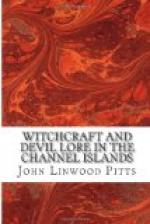girl of nine years old, are said to have been hanged
as witches at Huntingdon, but of this there seems
to be some doubt. The last really authentic
trial in England for witchcraft took place in
1712, when the jury convicted an old woman named
Jane Wenham, of Walkerne, a little village in
the north of Hertfordshire, and she was sentenced to
be hanged. The judge, however, quietly procured
a reprieve for her, and a kind-hearted gentleman
in the neighbourhood gave her a cottage to live
in, where she ended her days in peace. With
regard to the mobbing of reputed sorcerers, it is
recorded that in the year 1628, Dr. Lamb, a so-called
wizard, who had been under the protection of the
Duke of Buckingham, was torn to pieces by a London
mob. While even as late as April 22nd, 1751,
a wild and tossing rabble of about 5,000 persons
beset and broke into the work-house at Tring,
in Hertfordshire, where seizing Luke Osborne and his
wife, two inoffensive old people suspected of
witchcraft, they ducked them in a pond till the
old woman died. After which, her corpse
was put to bed to her husband by the mob, of
whom only one person—a chimney-sweeper named
Colley, who was the ringleader—was
brought to trial and hanged for the detestable
outrage.
The laws against witchcraft in England had lain dormant for many years, when an ignorant person attempted to revive them by filing a bill against a poor old woman in Surrey, accused as a witch; this led to the repeal of the laws by the statute 10 George II. 1736. Credulity in witchcraft, however, still lingers in some of the country districts of the United Kingdom. On September 4th, 1863, a poor old paralysed Frenchman died in consequence of having been ducked as a wizard at Castle Hedingham, in Essex, and similar cases have since occurred; while on September 17th, 1875,—only ten years ago—an old woman named Ann Turner, was killed as a witch, by a half-insane man, at Long Compton, Warwickshire.
IN SCOTLAND, thousands of persons were burnt for witchcraft within a period of about a hundred years, in the fifteenth and sixteenth centuries. Among the victims were persons of the highest rank, while all orders of the state concurred. James I. even caused a whole assize to be prosecuted because of an acquittal; the king published his work on Daemonologie, in Edinburgh, in 1597; the last sufferer for witchcraft in Scotland was at Dornoch, in 1722.
CONFESSIONS OF WITCHES UNDER TORTURE.
LE 4 JUILLET 1617.
Devant AMICE DE CARTERET, Ecuyer, Baillif, presents, etc.
SENTENCE DE MORT.




